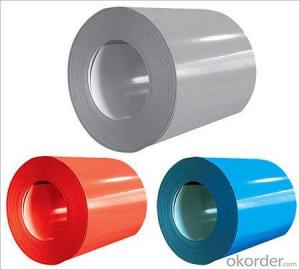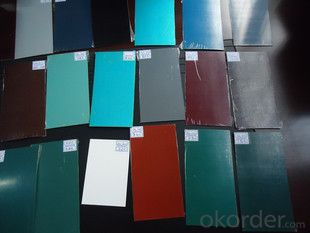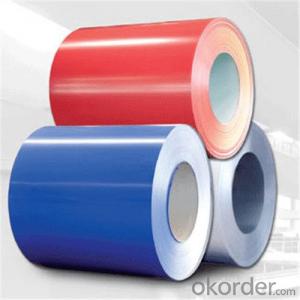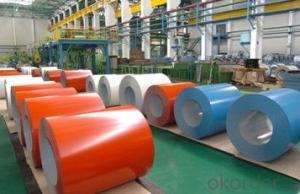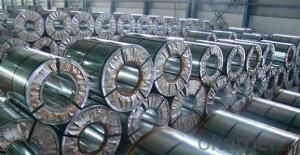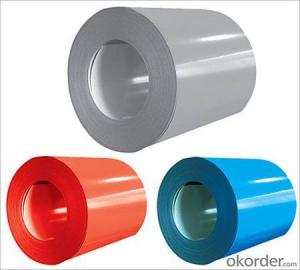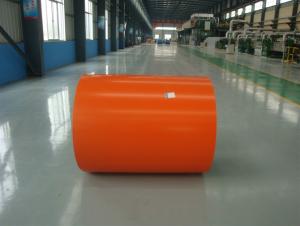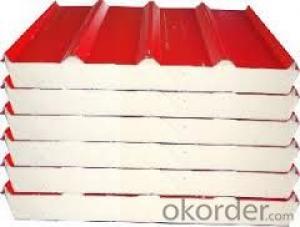Hot dipped galvanized prepainted steel coils
- Loading Port:
- Shanghai
- Payment Terms:
- TT OR LC
- Min Order Qty:
- 1 m.t.
- Supply Capability:
- 300000 m.t./month
OKorder Service Pledge
OKorder Financial Service
You Might Also Like
Specifications
GALVANZIED STEEL COIL(GI)
1,Base Metal:COLD ROLLED(CR)
2,Zinc Coating: z40-z275
3,Thickness:0.15mm-4.0mm(GI)
4,Width:914mm-1250mm
5,Length: according to your requirement (unit of measurement: Ton)
6,Minimum order:25Tons
7,Packaging Details: Fully seaworthy export packing
8,Price Terms:FOB,CIF,CF
9, Terms of payment:T/T 30% in Advance,70%T/T after the copy of B/L or L/C at sight.
10, Coil weight:3-10 ton or client's suggestion
11, Width tolerance:±10mm
12, Spangle:zero spangle , min spangle , regular spangle, big spangle
13.Hot dipped galvanized steel coil & opened sheets
Hot Dipped Galvanized Steel Coil
Range and Production Capacity
| 1# hot dip galvanizing unit | 2# hot dip galvanizing unit | 3# hot dip galvanizing unit | 4# hot dip galvanizing unit | |
Highest process speed m/min | 150 | 150 | GI 160 | 150 | |
GA 60 | |||||
Thickness | 0.25~1.2 | 0.25~1.2 | 0.25~2.0 | 0.15~0.8 | |
Width | 700~1250 | 800~1250 | 800~1350 | 700~1250 | |
Mass of coating g/m² | 60~305 | 60~305 | 60~450 | 60~450 | |
Steel coil inner diameter (mm) | 508/610 | 508/610 | 508/610 | 508/610 | |
Production capacity | 30 | 30 | 30 | 15 | |
Surface structure | Smooth, zero spangle | ||||
Surface treatment | Oiling, passivation or non-chrome passivation, passivation plus oiling, non-chrome passivation plus oiling, fingerprint resistance or non-chrome fingerprint resistance. | ||||
Number and Standard
No.,standard, variety | No. | Executive standard | Application and characteristics |
Stamping steel | DX51D+Z,DX51D+ZF | GB/T 2518 | Ordinary use, mechanical seaming, deep punching, and ultra-deep punching. Coating and welding performances of alloying hot galvanizing are better. |
DX52D+Z,DX52D+ZF | |||
DX53D+Z,DX53D+ZF | |||
DX54D+Z,DX54D+ZF | |||
Structural steel | S220GD+Z,S220GD+ZF | GB/T 2518 | Used for structure. Good corrosion resistance and processability. |
S250GD+Z,S250GD+ZF | |||
S280GD+Z,S280GD+ZF | |||
S320GD+Z,S320GD+ZF | |||
S350GD+Z,S350GD+ZF | |||
S400GD+Z,S400GD+ZF | |||
S500GD+Z,S500GD+ZF |
- Q: How are steel coils used in the production of metal enclosures?
- Due to their versatility and strength, steel coils find extensive use in the manufacturing of metal enclosures. Typically made from high-quality steel, these coils serve as the primary raw material for producing metal enclosures. To begin with, specialized machinery is employed to unroll and flatten the steel coils to the desired thickness. This step ensures that the coils are suitable for further processing. Subsequently, the flattened steel is cut into specific sizes and shapes, according to the design requirements of the metal enclosure. Following this, various techniques such as bending, folding, and welding are utilized to mold the cut steel pieces into the desired shape. These processes enable the steel to be formed into the required dimensions and structure of the metal enclosure. The inherent strength and durability of the steel coils ensure that the final product is robust and capable of withstanding external forces or impacts. Moreover, steel coils can be coated with protective layers such as galvanization or powder coating to enhance their resistance to corrosion, rust, and other environmental factors. This coating helps to extend the lifespan of the metal enclosure while maintaining its aesthetic appeal. Furthermore, the use of steel coils in the production of metal enclosures allows for customization and flexibility. The coils can be easily manipulated to create complex shapes or designs, facilitating the customization of enclosures to meet specific customer requirements. This adaptability makes steel coils a preferred choice in industries such as automotive, electronics, and construction, where metal enclosures are widely used. In conclusion, steel coils are essential in the manufacturing of metal enclosures as they provide a strong and versatile raw material. These coils are transformed into the desired shape and size, ensuring the durability and functionality of the enclosures. With their customizable nature and protective coatings, steel coils offer a cost-effective solution for producing high-quality metal enclosures.
- Q: How are steel coils inspected for formability using forming tests?
- To assess their ability to be shaped into desired forms without any defects or failures, steel coils undergo inspections for formability through the use of forming tests. These tests are conducted to evaluate the mechanical properties of the material and determine if it is suitable for specific applications. Forming tests consist of subjecting the steel coil to different forming operations, such as bending, deep drawing, or stretch forming. The coil is typically cut into specific dimensions and then subjected to these operations using specialized equipment. The main objective is to replicate the actual forming process that the steel will experience in real-world applications. During the forming tests, several parameters are carefully monitored. These parameters include the amount of force or load applied, the rate of deformation, and the resulting strain or deformation experienced by the steel. Additionally, the response of the coil to these operations is observed, including any visible defects like cracks, fractures, or surface imperfections. By thoroughly analyzing the performance of the steel coil during the forming tests, various characteristics related to formability can be determined. These characteristics include the material's ability to resist deformation, its capacity to withstand strain without failure, and its tendency to exhibit defects under specific forming conditions. The results obtained from these tests provide valuable insights into the suitability of the steel coil for particular forming processes and applications. Furthermore, advanced techniques such as digital image correlation and strain analysis can be utilized to precisely measure and evaluate the distribution of strain across the surface of the steel coil. These techniques assist in identifying areas of the coil that experience higher strain and potential points of failure. In summary, the formability of steel coils is assessed through forming tests that simulate the actual forming processes they will undergo. These tests evaluate various formability characteristics, including the material's resistance to deformation and its likelihood of defects. The results obtained from these tests aid in determining the suitability of the steel coil for specific applications and guide the selection of appropriate forming parameters.
- Q: How are steel coils inspected for surface cleanliness after processing?
- Steel coils are inspected for surface cleanliness after processing through visual examination, using techniques such as optical scanning or high-resolution cameras. Additionally, other methods like acid etching or solvent cleaning may be employed to remove any contaminants or residues on the surface to ensure the coils meet the required cleanliness standards.
- Q: I bought a damascus steel knife. It will be used for display. Nothing like hunting/skinning. If It is just sitting around, will it rust? (assuming that it isn't getting wet) Thanks for the help.
- For many spo Damascus Knifertsmen, a hunting knife is one of the most important and cherished pieces of outdoor equipment they will ever own. Hunting knives are used for everything from cutting rope to field dressing a fresh kill, which means they need to be strong, sharp, durable and able to withstand the rain. Many avid out doors men prefer to invest in a high-quality hunting knife that will last for years and will perform reliably in the field. Because of this desire for reliability and quality workmanship, the Damascus blade knife has become an increasingly popular choice within the past few decades. Following is a look at what a Damascus knife is and why it’s so coveted by hunters.
- Q: How are steel coils used in the production of wind turbine components?
- Wind turbine components rely heavily on steel coils for their production. These coils, typically crafted from high-strength steel, possess remarkable durability and resilience against harsh weather conditions. The tower, which serves as the wind turbine's main support structure, heavily relies on steel coils. These coils are used to construct the tower sections, which are then assembled to create a sturdy and tall structure capable of withstanding the weight of the nacelle and rotor blades. Steel coils also find essential application in the manufacturing of the rotor blades. Responsible for capturing wind energy and converting it into rotational motion, the rotor blades require a strong internal structure called the spar, which is constructed using steel coils. These coils are shaped and formed to achieve the desired blade shape, with composite materials added to enhance aerodynamic properties. Moreover, steel coils are utilized in the production of other wind turbine components like the hub and the nacelle. The hub, located at the center of the rotor, demands a robust steel structure to endure the immense forces generated by the rotating blades. The nacelle, which houses crucial turbine components such as the generator, also incorporates steel coils in its construction to ensure stability and protection. To summarize, steel coils play a vital role in the production of wind turbine components. From the tower to the rotor blades, hub, and nacelle, these coils provide the necessary strength, durability, and stability required to withstand the demanding conditions of wind energy production. Without them, the construction and operation of wind turbines would be impossible, as they serve as the backbone of these renewable energy systems.
- Q: for a roof spanning 14.4m x 8.4m on a residential house, is it better to use timber trusses or steel trusses? the priorities are; ease of construction, price, insulation (want to keep heat out, i am in a tropical country), durability, flexibility, minimal load on foundations.please help. thank you :-)
- U will to find details on metal trussesin constructing materials AND development through BINDRA AND ARORA and u may additionally to find them in MCKAY(B.M.C).About steel doors and windows search the net u can search in google or yahoo u will to find it . Ok bye bye all of the exceptional.
- Q: Can anyone tell me what that means. I have seen it on knife blades an such. I am assuming it's a formula for the strength of the metal. who does that scale work, and please keep it simple.
- The number just indicates which class of steel alloy it belongs. Yours happens to be a 400 series and happens to have no Nickel in it (440 Steel) and a higher amount of carbon (Nickel is very common in steel) When I say alloy, I'm referring to the different chemical formulas and processing of steel which vary for different uses like industrial use, medical use or decorative use. Think of the different alloys like the types of soft drinks out there. Coke, Pepsi and Dr. Pepper. They all have very similar chemical formulas; yet differ with their secret ingredients which is apparent in the taste.
- Q: Can I ever get my classical guitar reinforced so it can have steel strings on it?
- NO. A classical guitar is braced very differently than a steel-string acoustic. Plus the set-up is completely exceptional - the best way the nut is slotted, the best way the strings tie on the bridge, and so on. The anxiety of steel strings would pull the bridge and top off of a just right classical guitar. Although it's a mass-produced cheap person who would take the tension - you'll certainly not be capable to play it - the action on a nylon string guitar is far better in most cases. Who cares how long strings last - you're talking about $5-10 for a suite of strings. Changing strings is part of playing guitar.
- Q: How are steel coils used in the production of HVAC equipment?
- Steel coils are commonly used in the production of HVAC equipment as they serve as the primary component in heat exchangers. These coils are responsible for transferring heat between the refrigerant and the air, allowing the equipment to cool or heat the surrounding space effectively. The steel coils are designed to maximize surface area and optimize heat transfer, ensuring efficient and reliable operation of HVAC systems.
- Q: Can steel coils be used in outdoor applications?
- Indeed, outdoor applications can make use of steel coils. Steel, recognized for its resilience and robustness, proves to be ideal for various outdoor purposes. Commonly utilized in construction, automotive manufacturing, and transportation industries, steel coils exhibit resistance against adverse weather conditions like rain, snow, and UV exposure. Furthermore, to enhance their durability and prolong their lifespan, steel coils frequently undergo protective finishes such as galvanized or painted coatings. Ultimately, owing to their strength, durability, and ability to withstand environmental factors, steel coils emerge as a dependable and versatile choice for outdoor applications.
Send your message to us
Hot dipped galvanized prepainted steel coils
- Loading Port:
- Shanghai
- Payment Terms:
- TT OR LC
- Min Order Qty:
- 1 m.t.
- Supply Capability:
- 300000 m.t./month
OKorder Service Pledge
OKorder Financial Service
Similar products
Hot products
Hot Searches
Related keywords
